The application of conversational AI involves using voice and text-based dialog management systems to interact with users and provide answers to their questions. While text-based systems have been used for some time, their success has been inconsistent due to rushed deployment by some businesses resulting in frustrated users.
However, recent successes such as ChatGPT have shown that the technology has matured, but it requires an understanding of the complex levels of conversation necessary to create effortless dialogs that mimic human communication.
Although conversational AI has had both failures and successes, it is gaining traction in various fields, thanks to the widespread adoption of 4G and 5G-enabled mobile phones, wearables, and virtual and augmented reality devices. The adoption rate of conversational AI has experienced a dip, but there are reasons to believe it will rise again quickly as technology, design, and approach improve.
To make conversational AI successful, it is crucial to reduce abandonment rates and drive adoption. This applies to both text and voice-based dialog systems. But what does this mean in terms of technology?
DEVELOPING ENGAGING CONVERSATIONS FOR CONVERSATIONAL AI
Conversational AI is a complex field that involves more than just inputting vast amounts of conversational data. Unlike AI systems, human interaction has evolved over thousands of years. Teaching computers to recognize the subtle nuances of human communication can be challenging, and requires expertise.
The complexity of Conversational AI extends beyond language understanding and includes conversational flow and integration. People often ask questions that require either a simple or a more complex response. If these questions are not addressed in the appropriate manner and at a reasonable speed, users may abandon the conversation immediately and be hesitant to continue using it. This poses a challenge to businesses that rely on conversational AI as a communication tool.
The successful adoption of Conversational AI systems is influenced by three main factors, similar to any human conversation.
The first is selecting the appropriate use case, as both informational and transactional dialog systems can be utilized, and the selection should depend on intent volume and variety. The second factor is designing a human-centered conversation that requires minimal human interaction, using a strong copywriting approach that mimics human dialog patterns. The third factor is to track the conversation’s accuracy and progress using a data loop to continually enhance model performance and system outcomes.
- Choosing the Right Use Case is crucial for the success of Conversational AI implementation. It’s important to carefully select the topics to be addressed based on the volume of intent and the variety of all intents. This becomes critical because of the non-deterministic nature of the solution, and these two metrics directly impact achieving business objectives and reducing abandonment rates.
- Human-Centered Conversational AI Design is about understanding human dialog patterns and acknowledging the limitations of technology. Strong copywriting plays a critical role in making the conversational AI experience human-like and enables human-machine interaction at the right place. This results in better conversation completion, addresses user queries, and lowers abandonment rates.
- The Data/Feedback Loop is essential in capturing data to understand the behavior of Conversational AI at both the business and model level. This way, corrective measures can be taken earlier, and customer experience can be kept on track. Sentiment analysis is a critical metric for training and fine-tuning the system, which can lead to an overall positive customer experience.
USING A HYBRID DESIGN APPROACH TO SWITCH SEAMLESSLY AND KEEP USERS ENGAGED
To ensure users stay engaged, it is important for businesses to seamlessly switch between machine and human interactions when implementing Conversational AI for everyday transactions such as order tracking or providing information.
A hybrid design approach can achieve this by allowing for both machine-driven and human-driven conversations to complete the task.
The success of machine-driven/rule-based conversations hinges on personalized algorithmic recommendations based on users’ interests and context, as well as a robust natural language understanding (NLU) model capable of addressing a variety of topics and intents using single or code-mixed language. A strong NLU model can comprehend multiple intents and perform quantitative reasoning, providing a more human-like interaction and improving the overall customer experience.
CHALLENGES IN DEPLOYING CONVERSATIONAL AI
The typical challenges in deploying conversational AI include issues with setup, such as training data and maintenance, which can deter enterprises from adopting chatbots.
To ensure the success of conversational AI systems, it is crucial to not only focus on their technological capabilities but also on their implementation. Defining the business metric and its corresponding AI metric during the early stages can help guide the system’s design.
When designing any conversational AI system, it is essential to consider achieving business metrics such as customer satisfaction, adoption rate, customer support efficiency, and customer support volume, and map them to their respective AI metrics. By getting this right from the start, conversational AI dialog systems can achieve better adoption rates and lower abandonment rates.
THE FUTURE OF CONVERSATIONAL AI ADOPTION IS EVIDENT AND PROMISING
It’s a well-known fact that Covid19 has hastened the adoption of Conversational AI. Going forward, as businesses and customers continue to prefer digital-first services, the adoption rates are expected to skyrocket.
The growth will be driven by industries focusing on training agents, handling intricate conversations, and achieving hyper-personalization. The way forward is to transition from being conversational to being engaging, regardless of the industry, function, user environment, or device. Ultimately, the goal is to evolve from being engaging to being sentient.
Thank you for reading. For continued insights and in-depth discussions, please follow our blogs at Odio.

Leave a Reply